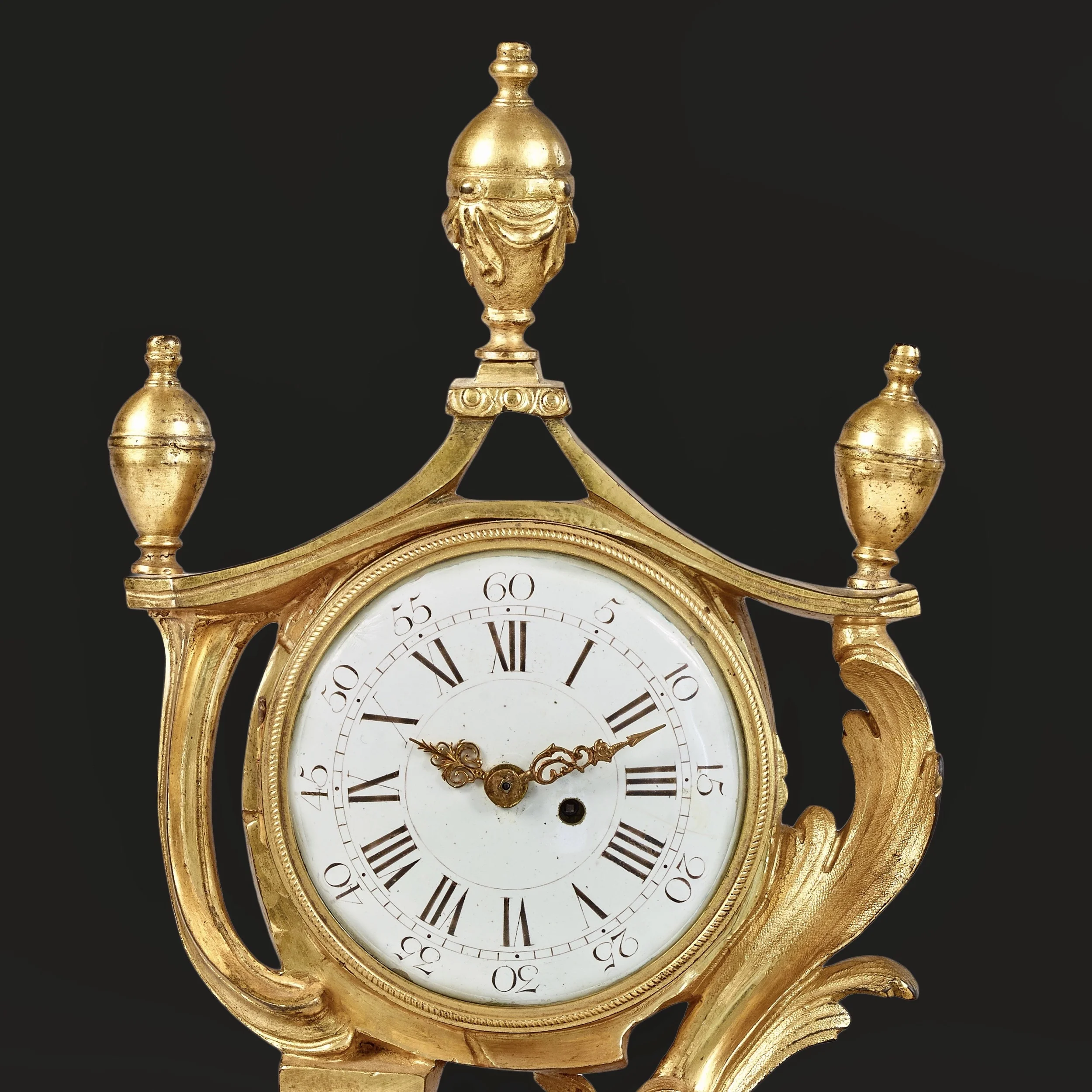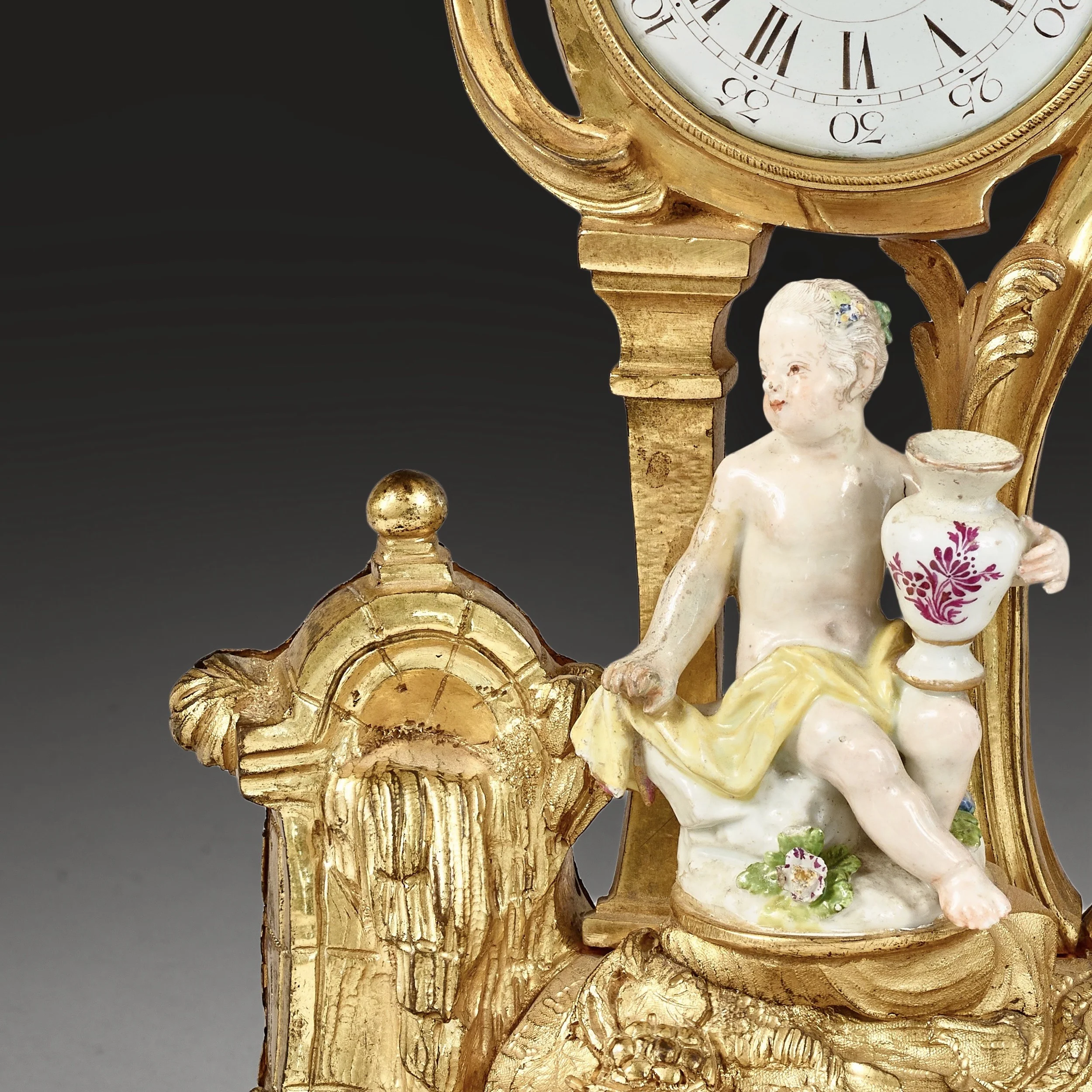Watch-holder trinket
- Description
- Histoire
France, Louis xv period
Meissen porcelain (restoration on the porcelain)
The Louis xiv watch movement signed Asselin à Rouen
(governor of “Gros Horloge” in Rouen)
The movement is a Louis xiv watch movement and operates over 24 hours
Chased and pierced gilt bronze
Height: 34 cm – 13 ½ inches
Length: 21 cm – 8 inches
Depth: 9,5 cm – 3 ½ inches
Meissen porcelain
The first European porcelain, similar to that of the Chinese, was a real economic stake. It was manufactured in Saxony since 1709. Indeed, in 1694, when the king of Poland Frederick Augustus ii received the title of elector of Saxony, he asked his financial advisor, Ehrenfried Walther von Tschimhaus to draw up a report on the wealth of Saxony. In 1709, with the assistance of the young alchemist Frédéric Böttger, he would have discovered kaolin deposits, raw material of hard porcelain. By order of Frederick Augustus, a factory was immediately founded in the fortress of Albrechtesberg in Meissen. Every precaution was taken to prevent disclosure of the porcelain creation process. As early as 1710, the first specimens of white porcelain made from kaolin and covered with limestone were presented to the king. From 1710 to 1719, Johann Friedrich Böttger developed porcelain material and from 1720 to 1731, Johann Gregorius Höroldt devoted himself to the development of the small fire palette, the colours of which are applied after a first firing of the paste and which are fired during a second process. Johann Joachim Kändler (1706-1775) was responsible for the development of statuary in Meissen from 1731 when he was hired as a master modeler. Thanks to the technical advances of the manufacture, he raised the production of sculpted objects to its highest degree of virtuosity, which would quickly be collected throughout Europe.
Gilt bronze mounts
Sumptuously mounting objects in order to present them with a particular brilliance is an ancient practice. As early as the Middle Ages, rare stone cups or vases and, in the 15th century, even porcelain was set in gold or silver. While gold and silver continued to be used in the 17th century, gilt bronze mounts experienced an unprecedented rise at the end of the reign of Louis xiv, thereby responding to the need for economy that marked this period. Subsequently, throughout the 18th century and, most of the time thanks to the intervention of important marchands merciers, exceptional pieces were entrusted to great bronzers who then created extremely refined mounts. With substantial means, greater than those of most artisans, these merchants indeed had the ability to acquire precious objects in rare materials such as hard stones, porcelain, ivory, coconut, petrified wood or even mother-of-pearl. We owe the idea to some of these most talented merchants of raising porcelain in precious metals to enrich them and to associate them with watch mechanisms as is the case with this watch-holder. In response to the taste for small Meissen porcelain statuettes, this watch-holder trinket is thus a reflection of the combined talent of the bronzers, gilders, chasers and watchmakers to create exceptional pieces, probably here at the request of one of these merchants.
A Louis xiv watch
The mechanism of this little trinket is a Louis xiv watch. It was indeed not uncommon for merchants to reuse older mechanisms.
Originally probably used in a pocket watch or a gusset watch, this very small mechanism was particularly suitable for small objects. We can distinguish at the back of the trinket the rooster used to protect the balance, in gilt brass, composed of foliage, birds and a basket of flowers.
In the 18th century, marchand mercier were merchants of works of art and intermediary between clients and producers from whom they were the patrons.
Bibliography
- Pierre Kjellberg, Objets montés du Moyen-Âge à nos jours, Paris, Éditions de l’Amateur, 2000, p. 34.
- Lunsingh D. F. Scheurleer, Chinese und japanisches Porzellan in europäischen Fassungen, Braunschweig, Klinkhardt & Biermann, 1980.
- Pierre Verlet, Les bronzes dorés français du xviiie siècle, Paris, Éditions Picard, 1987.
- Giacomo et Rozenn Wannenes, Les bronzes ornementaux et les objets montés, de Louis xiv à Napoléon iii, Milan, Editions Vausor, 2004, p. 94–95.



